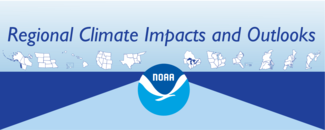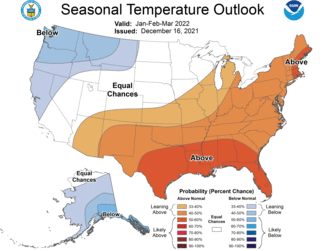
NOAA and its partners have released the latest Regional Climate Impacts and Outlooks, which recap autumn conditions and provide insight into what might be expected this winter.
Autumn Temperature Recap
During meteorological autumn (September-November), the average temperature for the Lower 48 was 56.7°F, 3.1°F above average, ranking third warmest in the historical record. Autumn temperatures were above average across most of the contiguous U.S. Montana, Wyoming and Colorado ranked second warmest for this three-month period with 14 additional states ranking among their five warmest autumns. The Alaska statewide average temperature for autumn was 23.8°F, 2.1°F below average, ranking in the coldest third of the historical record. Temperatures were below average across much of the West Coast, western Interior, south-central and southeastern portions of the state.
Winter Temperature Outlook
The January through March 2022 temperature outlook favors above-normal seasonal mean temperatures for the south-central and eastern U.S. The largest probabilities (above 50 percent) for above-normal temperatures are forecast across much of the Gulf Coast States and parts of New England. Probabilities of below-normal temperatures are elevated for parts of the northern High Plains, northern Rockies, Pacific Northwest, northern California, and most of Alaska.
Autumn Precipitation Recap
The national autumn precipitation total was 6.81 inches, 0.07 inches below average, ranking in the middle third of the historical record. Precipitation was above average across parts of the West, northern Plains, Ohio Valley, Northeast and Southeast. Washington state ranked sixth wettest for this three-month period. Precipitation was below average across portions of the Southwest, northern Rockies, central to southern Rockies, southern Plains, Lower Mississippi River Valley, western Great Lakes, and the Carolinas and Virginia. Autumn statewide precipitation ranked in the driest third of the historical record in Alaska.
Winter Precipitation Outlook
The January through March 2022 precipitation outlook favors below-normal seasonal precipitation amounts from southern California and the Southwest east to the southern Great Plains along with parts of the Southeast. Below-normal precipitation is slightly favored for coastal southern Alaska. Above-normal seasonal precipitation amounts are most likely across the Great Lakes, Ohio and Tennessee Valleys, northern Rockies, Pacific Northwest, and western mainland Alaska. Equal chances (EC) are forecast among areas where seasonal mean temperatures and seasonal precipitation amounts are expected to be similar to climatological probabilities.
Impacts and Outlooks for Your Region
Get more details for your region in the December 2021 climate impacts and outlooks summaries:
- Alaska and Northwestern Canada Region
- Mid-Atlantic Region
- Northeast Region
- Great Lakes Region
- Gulf of Maine Region
- Midwest Region
- Missouri River Basin Region
- Pacific Region
- Southeast Region
- Southern Region
- Western Region
Creating These Quarterly Summaries
NOAA’s Regional Climate Services lead the production of these quarterly summaries of climate impacts and outlooks for various regions of the United States, as well as parts of Canada along the border. This effort, which began in 2012, now includes as many as 11 unique regional products, all produced collaboratively with partner organizations.
You can access all of the Climate Impacts and Outlooks summaries, as well as additional reports and assessments, through the U.S. Drought Portal Reports web page at Drought.gov.





